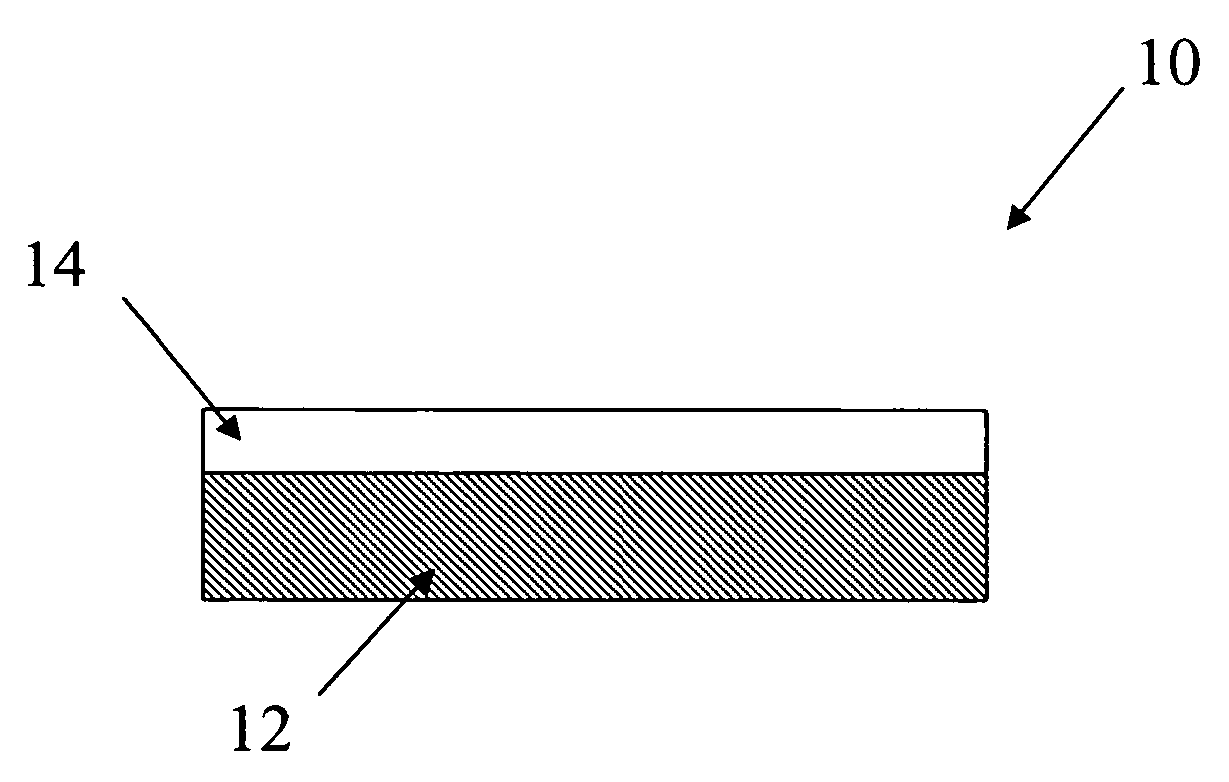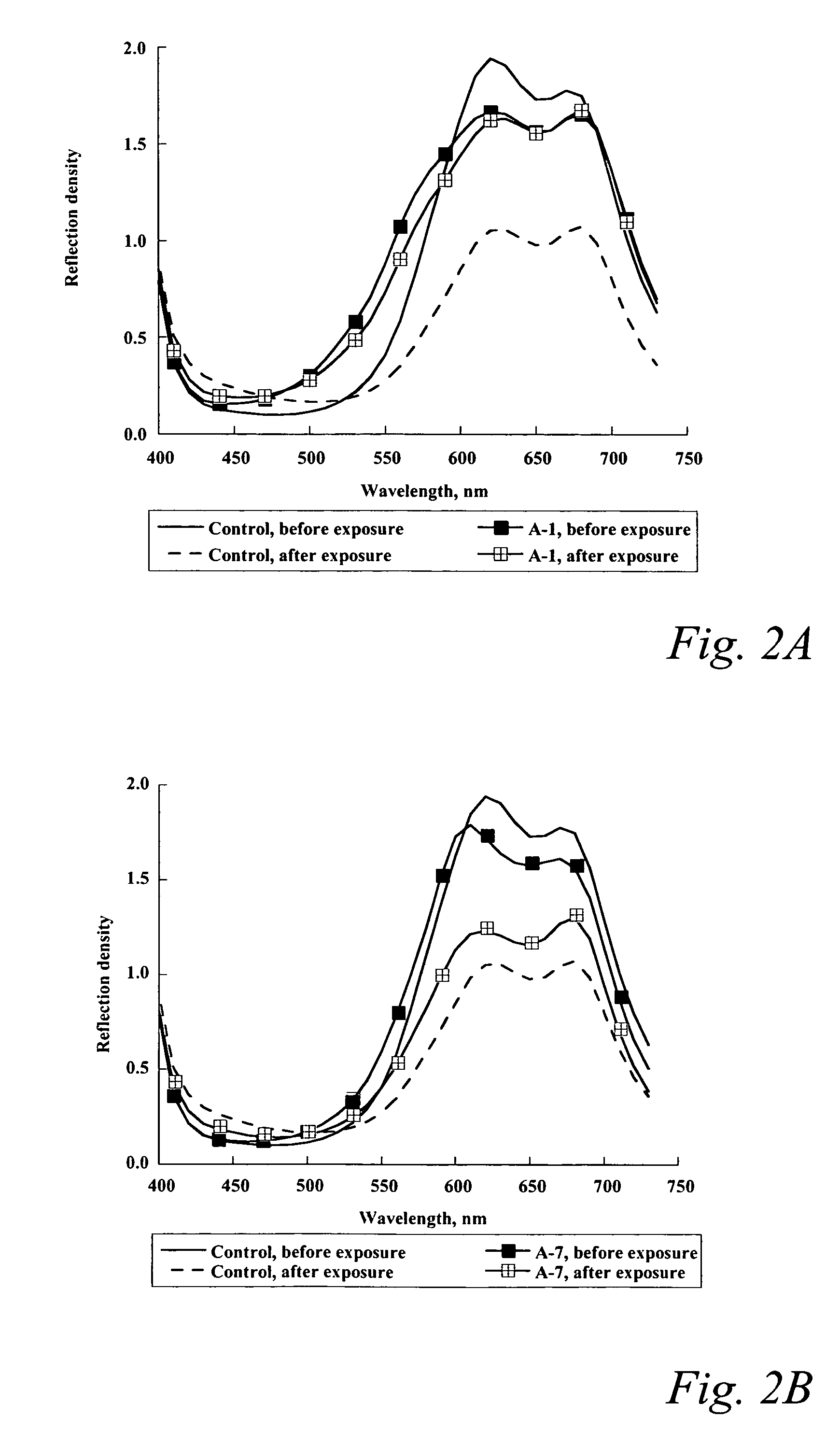Imaging compositions, imaging methods and imaging members
a technology of compositions and compositions, applied in the field of imaging compositions and imaging members, can solve the problems of high susceptibility to ozone fading of color images, including those made by any imaging method, and achieve the effect of improving ozone stability
- Summary
- Abstract
- Description
- Claims
- Application Information
AI Technical Summary
Benefits of technology
Problems solved by technology
Method used
Image
Examples
examples
[0074]The method of the invention will now be described further with respect to specific preferred embodiments by way of examples, it being understood that these are intended to be illustrative only and the invention is not limited to the materials, amounts, procedures and process parameters, etc. recited therein. All parts and percentages are by weight unless otherwise specified.
example i
[0075]Coatings of a control copper phthalocyanine dye and of imaging compositions according to the invention were formed on a polyethylene terephthalate sheet. The copper phthalocyanine dye was Solvent Blue 70. The dye(s) were dissolved in n-butanol at a concentration of about 3.23% of copper phthalocyanine (Solvent Blue 70) and about 0.77% of aminoanthraquinone dye (Solvent Blue 14), coated on the substrate and dried in air at ambient temperature (˜22-24° C.) for about 5 to 10 minutes. The thickness of the dye layers was about 0.5 μm.
[0076]The coatings were exposed to 10 ppm ozone for one hour in an ozone generating chamber made up of a pyrex jar and a mercury argon lamp. The ozone was produced in situ by the direct photolysis of oxygen in the ambient air in the chamber. A fan within the chamber ensured that all the coatings were uniformly exposed to the ozone.
[0077]A Gretag SPM50 densitometer was used to measure and record the reflection density, calorimetric parameters and spectr...
example ii
[0081]A control thermal imaging member and a thermal imaging member according to the invention were prepared. Initially a coating composition was prepared containing the dye (2% w / w) and the appropriate amount of a thermal solvent in 1-butanol. The solution was then coated on an approximately 4.5 μm thick poly (ethylene terephthalate) film base which had a slip coating for thermal printing on the opposite side using a #7 Meyer rod. The coating was dried using warm air.
[0082]After drying the resulting donor element was placed over a receiver sheet of the type described in U.S. Pat. No. 6,761,788 B2, with the coated side of the donor element in contact with the microporous receiver coating. The resulting assembly was printed using a laboratory test-bed printer equipped with a thermal head supplied by Kyocera Corporation, Kyoto, Japan, as described below.
[0083]The control was prepared by forming a solution of about 2% copper phthalocyanine dye (Solvent Blue 70) and 5% of a thermal solv...
PUM
| Property | Measurement | Unit |
|---|---|---|
| melting point | aaaaa | aaaaa |
| thickness | aaaaa | aaaaa |
| wavelengths | aaaaa | aaaaa |
Abstract
Description
Claims
Application Information
 Login to View More
Login to View More - R&D
- Intellectual Property
- Life Sciences
- Materials
- Tech Scout
- Unparalleled Data Quality
- Higher Quality Content
- 60% Fewer Hallucinations
Browse by: Latest US Patents, China's latest patents, Technical Efficacy Thesaurus, Application Domain, Technology Topic, Popular Technical Reports.
© 2025 PatSnap. All rights reserved.Legal|Privacy policy|Modern Slavery Act Transparency Statement|Sitemap|About US| Contact US: help@patsnap.com



